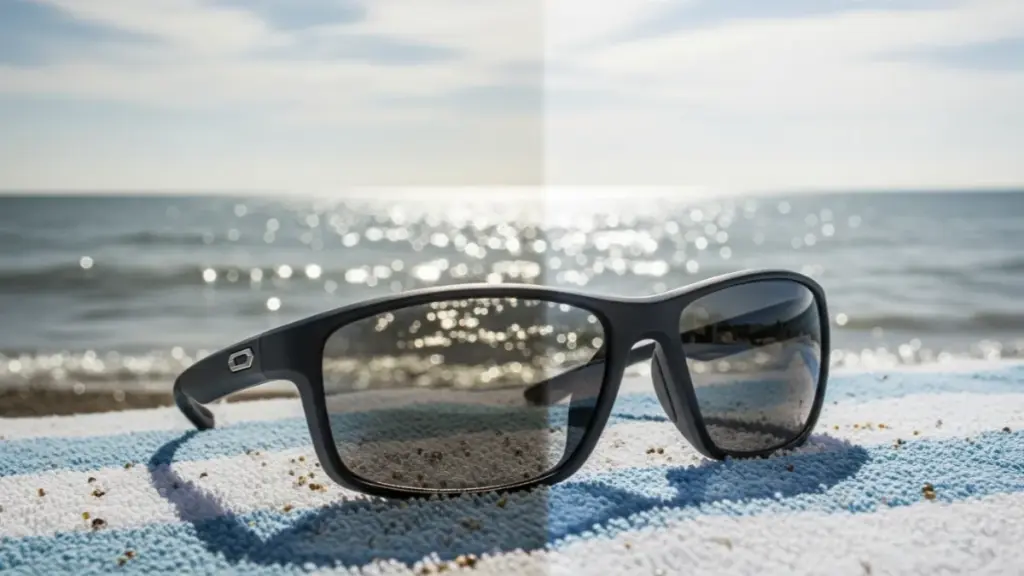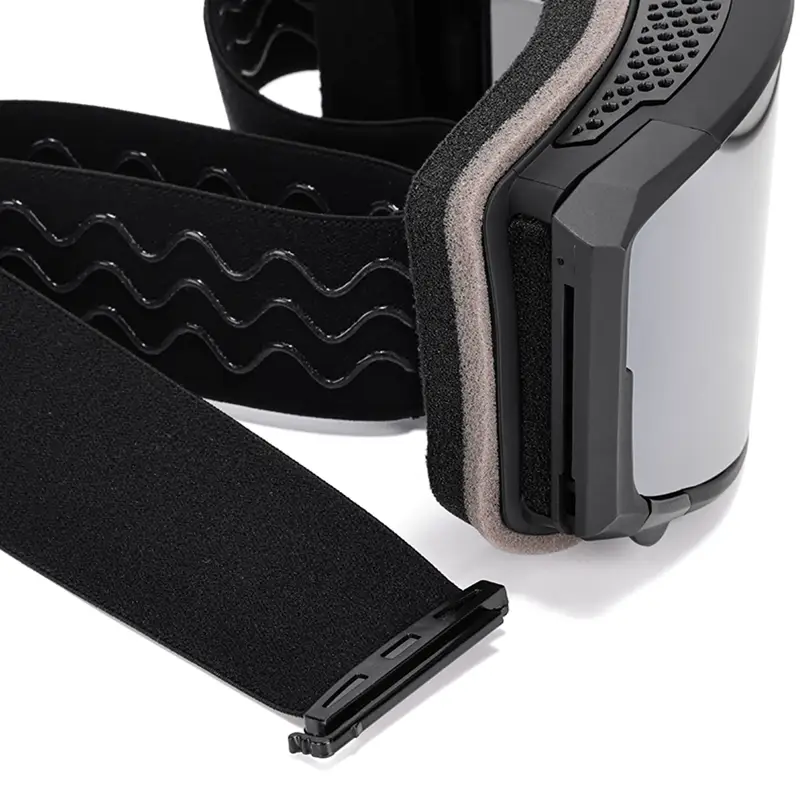What is UV400 Protection?

In the world of protective eyewear, various standards and terms are used, often creating confusion. しかし, one standard stands above all others as the benchmark for complete safety: UV400.
Understanding what “UV400” means is not just a matter of technical curiosity. It is a critical component of preventative health. This article will deconstruct the science behind UV400 protection, explain its non-negotiable role in maintaining ocular health, and clarify why this standard must be a foundational requirement for any quality pair of sunglasses.
UV400 Protection’s Importance for Eye Health
To grasp the significance of UV400, one must first understand the nature of the threat. Ultraviolet light is a segment of the electromagnetic spectrum, invisible to the human eye, with wavelengths shorter than visible light but longer than X-rays. This spectrum is primarily divided into three types:
- UVC (100-280 nm): Almost completely absorbed by the Earth’s ozone layer and not considered a significant threat to eye health.
- UVB (280-315 nm): These are the high-energy rays responsible for sunburn. They primarily affect the cornea and the lens of the eye.
- UVA (315-400 nm): These rays have a longer wavelength and penetrate more deeply into the eye, capable of damaging the central part of the vision, the retina, and the macula.
The term UV400 signifies that the sunglass lens is engineered to block 100% of this harmful light, filtering out all ultraviolet rays up to a wavelength of 400 nanometers.
This 400nm cutoff is critical because it covers the entirety of both the UVA and UVB spectrums. Cheaper or lower-quality lenses might only block UVB, or perhaps only block UV light up to 380 nm, leaving a dangerous “gap” that allows the most penetrating UVA rays to pass through.
Key Benefits of UV400 Protection in Sunglasses
The damage from ultraviolet radiation is both acute and cumulative. In the short term, high-intensity UV exposure, such as a day on the water or snow, an cause photokeratitis. This is essentially a sunburn of the cornea, a painful condition that can cause temporary vision loss, light sensitivity, and a “gritty” feeling in the eyes.
しかし, it is the long-term, cumulative damage that poses the most severe threat to vision.
- Cataracts: This is a clouding of the eye’s natural lens, which is the leading cause of blindness worldwide. Decades of research have established a direct, causal link between cumulative UV exposure and the acceleration of cataract formation. UV400 protection acts as a direct barrier, shielding the proteins in the lens from the denaturing effect of UV radiation.
- Macular Degeneration (AMD): UV400 is essential for protecting the retina. The UVA rays that lower-rated sunglasses miss can penetrate all the way to this light-sensitive tissue at the back of the eye. Chronic exposure is a significant risk factor for AMD, a condition that destroys the sharp, central vision required for reading, driving, and recognizing faces.
- Pterygium: Often called “surfer’s eye,” this is a non-cancerous growth on the white of the eye that can eventually grow over the cornea and obstruct vision. It is caused almost exclusively by chronic exposure to UV light.
- Eyelid Cancers: The delicate skin of the eyelid is highly susceptible to basal cell and squamous cell carcinomas. Sunglasses with a UV400 rating and sufficient coverage are a critical line of defense.
The long-term advantage of wearing UV400-compliant sunglasses is not one of comfort, but of preservation. It is the single most effective step one can take to mitigate environmental risk factors for permanent vision loss.
Comparing UV400 with Other UV Protection Ratings

The eyewear market is filled with confusing and often unregulated terms. A sticker simply reading “紫外線防御” または “Blocks UV” is ambiguous and, in many cases, dangerously misleading.
To understand the superiority of UV400, it helps to see the hierarchy of protection:
| Rating / Term | Scientific Meaning and Protection Scope | Consumer Risk / Warning |
| No Rating / “紫外線防御” | None of scientific meaning or specific standard. | High Risk: A pure marketing term that provides a false sense of security; may offer zero protection. |
| UV380 | Blocks 100% of UVB rays but only a portion of UVA rays (cuts off at 380 nm). | Critical Gap: Leaves a crucial exposure “gap” between 380 nm and 400 nm, allowing the most penetrating UVA-1 radiation to reach the retina. |
| “100% 紫外線防御” | Variable: Reputable manufacturers often use this interchangeably with UV400. | Be Cautious: If the “400” specificity is missing, the standard is open to interpretation, and protection may be uncertain. |
UV400 is the gold standard because it is absolute. It closes the 380-400 gap, ensuring that no damaging ultraviolet radiation, UVA or UVB, reaches any part of the eye. For environments with high exposure, such as high altitudes, snow-covered terrain, or open water, this full-spectrum coverage is not just recommended, it is medically necessary.
Verifying UV400 Protection in Sunglasses
それで, how can you verify true UV400 protection?
- Check the Labeling: Reputable manufacturers will always label their products explicitly. Look for a sticker, tag, or etching on the lens that states “UV400” または “100% UVA/UVB Protection.” In many regions, compliance with standards like ANSI Z80.3 (USA) or EN ISO 12312-1 (ヨーロッパ) implies this level of protection.
- Ask an Optometrist: The most reliable method. An optician or optometrist has a device called a UV spectrometer (or photometer) that can instantly measure the exact UV-blocking capability of any lens.
- Differentiate from Marketing: Be wary of vague terms. “UV-blocking” is not the same as “UV400.” Price is also not a guaranteed indicator, although quality manufacturing and testing cost money. The key is the specific standard to which the lens is certified.
The Manufacturer’s Standard

For retailers, brands, and even end-users, this verification process can be opaque. The consumer’s trust in a label is only as good as the manufacturer’s integrity.
As a specialist in private label eyewear manufacturing, this standard is not an add-on. It is the baseline for all products.
At Julong Eyewear, we embed UV400 protection as a non-negotiable technical requirement in our lens manufacturing process. This isn’t just a claim; it’s a verifiable specification backed by rigorous quality control and testing protocols. This is particularly vital in our line of スポーツサングラス, where athletes in cycling, mountaineering, or water sports face extreme and prolonged UV exposure from direct sun and reflected glare.
Partnering with a manufacturer who views UV400 not as a feature, but as a fundamental component of eye health, is the only way to guarantee that the final product delivers the absolute protection it promises.
UV Index and the Importance of Wearing UV400 Protection
Many people assume sunglasses are only necessary on “High” UV Index days. This is incorrect. The need for eye protection is constant, regardless of the weather or index.
- Cloud Cover is Deceptive: While heavy clouds block some UV, thin or scattered clouds can actually increase UV exposure by scattering the rays, creating a diffuse “all-sky” source of radiation. Up to 80% of UV rays can penetrate cloud cover.
- UV is Not Temperature-Dependent: A cool, breezy day can have the same high UV levels as a hot, still day. UV is present year-round.
- Winter and Reflection: Winter can be one of the most dangerous periods for UV exposure. Snow is highly reflective, capable of bouncing back 80% or more of UV rays, effectively doubling the dose your eyes receive.
The damage from UV is cumulative. It is the day-in, day-out exposure, year after year, that leads to cataracts and macular degeneration. UV400 sunglasses should be worn whenever one is outdoors during daylight hours, irrespective of the season, the weather, or the perceived UV index.
The Role of Polarized Lenses and UV400 Protection in Sunglasses

Another common point of confusion is the relationship between “偏った” そして “UV400.” These two features are completely independent and solve two different problems.
- UV400 Protection: This is a health feature. It blocks invisible, high-energy UV radiation to prevent physical damage to the eye.
- Polarization: This is a visual comfort そして clarity feature. It is a filter that selectively blocks horizontal light waves. This is the light that we perceive as glare when it reflects off flat surfaces like water, roads, or snow.
A lens can be one, the other, both, or neither. You can have a polarized lens with zero UV protection, or a UV400 lens that is not polarized.
Curious how to test if your sunglasses are truly polarized? Find out here.
結論
Are UV400 Sunglasses Worth the Investment? When all the science is considered, the question “Are UV400 sunglasses worth it?” is reframed. The true question becomes, “What is the cost of not having them?”
The “investment” in a pair of UV400-compliant sunglasses is negligible when compared to the potential cost—both financial and in quality of life—of treating conditions like cataracts or managing the irreversible vision loss from macular degeneration.




















